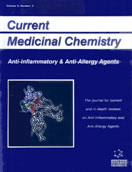Abstract
The review focuses on the application of macrobiomolecules and their derivatives that are capable of inhibiting ocular inflammatory and allergic responses. With a better understanding of molecular pathways of immunoregulation and the various factors involved in inflammation, and the concurrent development of modern technology, many macrobiomolecules have been utilized as immunomodulators. Ocular applications of macrobiomolecules have not been reviewed previously. Macrobiomolecules including compounds with peptide structure, compounds with nuclear acid and modified lipids have been successfully applied in the treatment of experimental and clinical ophthalmic diseases. These macrobiomolecules fall into categories, comprising: a) compounds with peptide structure, such as antiflammins and derivatives, antithrombins, and melanocyte-stimulating hormone (MSH); b) compounds with nucleic acid structure, such as immunostimulatory DNA sequences, antisense oligonucleotides, and ribonucleic acid; c) lipid compounds and their derivatives, such as fish oil, prostaglandin, ricinoleic acid, and oxidized lipid products; and d) other macrobiomolecules, including heparin and propolis. Antiflammins are an example of synthetic peptides with sequence homology to uteroglobulin that inhibit phospholipase A2. Topical administration of antiflammin suppresses acute ocular inflammation in experimental endotoxin-induced uveitis (EIU) and inhibited allergic responses in murine allergic conjunctivitis. Another example of macrobiomolecules that have immune stimulatory effects are the CpG-containing antisense oligonucleotides, also known as immunostimulatory oligonucleotides (ISS) or CpG motifs. CpG motifs enhance host responses against bacterial infection and have been exploited as a novel therapy to treat cancer, allergy and asthma. ISS also inhibits on-going Th2 response and induces a de novo Th1 response in murine allergic conjunctivitis. Additional macrobiomolecules, i.e., oxidized phospholipids, are recently reported to inhibit endotoxin-induced, or interleukin-1 & bgr;- induced, NFkB-mediated upregulation of inflammatory genes. These chemically synthesized phospholipids block the interactions among endotoxin, endotoxin-binding protein and CD14, resulting in the inhibition of inflammation induced by endotoxin. In conclusion, macrobiomolecules are potentially desirable therapeutic medications for ocular allergy and inflammation.
Keywords: ocular application, macrobiomolecules, anti-allergy, anti- inflammation, ophthalmic diseases, melanocyte-stimulating hormone, immunostimulatory dna sequences, endotoxin-induced uveitis, immunostimulatory oligonucleotides, mediated upregulation
 4
4

